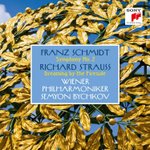|
Back
06/20/2017
Franz Schmidt: Symphony n° 2 in E-Flat major
Richard Strauss: Dreaming by the Fireside (Symphonic Interlude from “Intermezzo”)
Vienna Philharmonic, Semyon Bychkov (Conductor)
Recording: Grosser Saal Musikverein, Vienna, Austria (September 1-4, 2015) – 54’33
Sony Classics 88985355522 – Booklet in English, German and French

   
In between recording The Tchaikovsky Project: Volume I in Prague, Semyon Bychkov managed to squeeze in another engagement with the Vienna Philharmonic in this all-Austrian programme. Ambitious and assertive in disciplined Russian registry, this Leningrad native, nonetheless, managed to adeptly craft his expertise between opera house and concert hall. Well respected for interpretations by R. Strauss and Wagner, Mr. Bychkov exemplifies his ardor and candor in this Schmidt/Strauss contraction.
Though Franz Schmidt’s music is not, by any means, “mainstream”, his life’s timeline ran that of a close parallel to Richard Strauss. That said, Strauss’ influences can be seen (as) conservatively inculcating the Pressburg-native, evinced within his Symphony n° 2. This perennial Austro-Hungarian “Pastoral” œuvre is highly genteel with optimism frothing atop the key of E-Flat major.
Semyon Bychkov exudes iridescent, impressionistic expressions, musically parlayed inside the opening movement, “Lebhaft” (“Vivace”): we dwell in instantaneous bucolic reverie. The discovery of violins shimmering away depict a Magyar-esque babbling Donau tributary, reminiscent of Smetana’s Moldau (1875.) Subtle pizzicati help to “build” one thought, then the music fleetingly recedes. Nature flutters away at the score through chirpy flutes and other woodwinds. Lyrically lush, the theme returns thrice with Mr. Bychkov patiently building to a crescendo using strong brass bursts (i.e. Die Meistersinger) and powerful crests which strongly turn our heads to Der Rosenkavalier.
Each of the Vienna Philharmonic’s sectionals ponder its take on the agreeable melody Schmidt conjured inside the “Allegretto con variazioni” with a Bychkov tempo that’s always satisfying and matching the mood of the tune. While the first two variations are rather coy and polite (via woodwinds, then violins and violas, respectively), the pace moves more briskly in the third, adding heavier coloring through oboes and clarinets.
By variation five, the song has been expanded more broadly, using bounteous sweeps by violins, and there’s a sense of grandeur in the notes which remark at Aleksandr Glazunov’s Raymonda. If there’s any personal favoritism by Franz Schmidt in the music, it’s found in the eighth variation. This is where the composer pays affectionate tribute to his modern-day Bratislava birthplace. Here, Semyon Bychkov richly layers the orchestra in apropos fashion…undoubtedly a Straussian drizzle bleeds through. In the penultimate segment we return to optimistic flutes and piccolos, yielding fairy-tale like élan that, again, harken back to the ravishing score of Raymonda. Replete with organ, the crowning “Finale” utilizes Wagnerian powers to engulf the listener beyond words. The Vienna Philharmonic couldn’t be better positioned to create a breathless expression: one’s mouth is agape.
Franz Schmidt’s works are fitfully paired with Richard Strauss’ “symphonic interlude” culled from his bourgeois comedy, Intermezzo. Seldom-performed nowadays, the opera’s “intermissions” have been transmogrified into orchestral gems, and with just reason: these sectionals suffuse Richard Strauss’ delightful reaches of blissfulness. While Ulf Schirmer’s cadences are obviously more advanced than Mr. Bychkov, there’s good reason: Simone Schneider’s Christine maintains a justifiably nervous, paranoid momentum. Now that the piece has been turned into an instrumental concert-piece (fittingly renamed Dreaming by the Fireside), there’s better opportunity to make this into a heavily nuanced ethereal landscape. The Vienna Philharmonic’s legato is buttery, and it blossoms under the baton of Mr. Bychkov. Moments of solo violin and spouts by clarinets help aid the undulating waves of Richard Strauss’ very dreamy music. Beautifully rendered.
Christie Grimstad
|